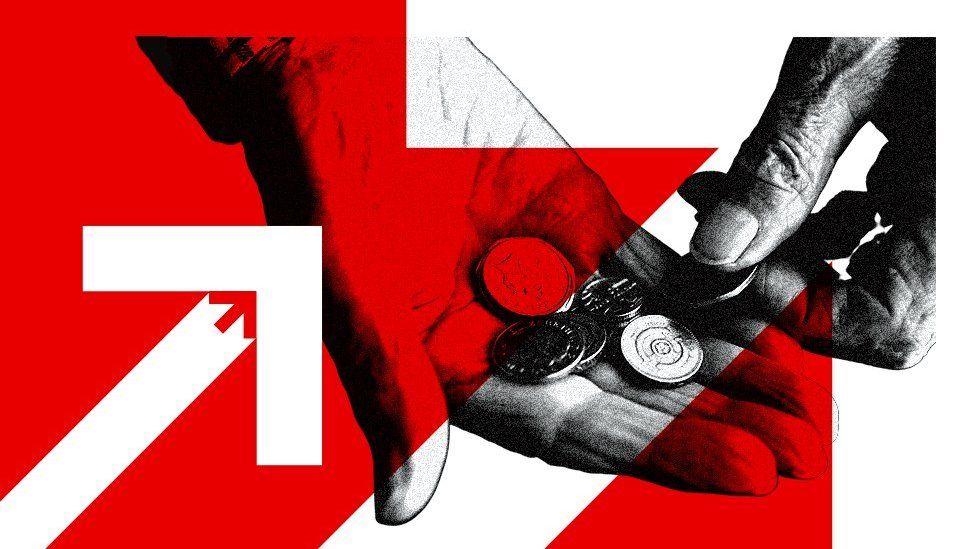The rate at which prices are rising remains high, driven by soaring food prices.

The rate at which prices are rising has dipped slightly, but remains high despite predictions it would come down further.
Soaring prices for bread, cereal and chocolate have helped push food prices to a 45-year high.
To help slow prices, the Bank of England has raised interest rates 12 times in a row, to 4.5% .
Inflation is the increase in the price of something over time.
If a bottle of milk costs £1 but £1.05 a year later, then annual milk inflation is 5%.
To come up with an inflation figure, the Office for National Statistics (ONS) keeps track of the prices of hundreds of everyday items in an imaginary "basket of goods" .
The basket is constantly updated, with the most recent changes seeing Alcopops removed and frozen berries added.
Each month's inflation figure shows how much these prices have risen since the same date last year.
You can calculate inflation in various ways, but the main measure is the Consumer Prices Index (CPI).
The latest figure for CPI was 8.7% in the year to April, down from 10.1% in March and 11.1% in October.
The soaring cost of food and energy have been key drivers of inflation.
Oil and gas were in greater demand as life got back to normal after Covid. At the same time, the war in Ukraine meant less was available from Russia , putting further pressure on prices.
The war has also reduced the amount of grain available , pushing up global food prices.
This effect was compounded in the UK in February by a shortage of salad and other vegetables , which took food inflation to a 45-year high.
Alcohol prices in restaurants and pubs also rose.
Pay increases for many people aren't keeping up with rising prices.
The average weekly salary in the UK, excluding bonuses, was £603 in April, up from £598 in March, according to official figures .
Throughout 2022, the average salary rose by nearly £3 a month.
But when you take inflation into account, the average salary actually fell by 1.3% in the three months to April, compared with the same period the year before.
Unions say wages should reflect the cost of living and many workers have been striking over pay .
However, the government argues big pay rises could push inflation higher because companies might increase prices as a result.
The Bank of England has a target to keep inflation at 2%, but the current rate is still more than five times that.
Its traditional response to rising inflation is to put up interest rates.
This makes borrowing more expensive, and can mean some people with mortgages see their monthly payments go up. Some saving rates also increase.
When people have less money to spend, they buy fewer things, reducing the demand for goods and slowing price rises.
Businesses also borrow less, making them less likely to create jobs, and may cut staff.
In May, the Bank increased interest rates for the 12th time in a row , taking the main rate to 4.5%.
The next interest rate announcement is on 22 June.
But when inflation is caused by factors such as global energy prices, action from the Bank of England may not be enough to slow it down.
Lower inflation does not mean prices fall. It just means they stop rising as quickly.
Announcing its latest interest-rate decision, the bank said inflation would "fall sharply in April" - those figures have yet to be released - but not as far or as fast as it had previously thought.
It says inflation is now expected to drop to 5% by the end of 2023, rather than the 4% previously predicted.
The Office for Budget Responsibility (OBR), which assesses the government's economic plans , had previously predicted inflation would fall back to 2.9% by the end of the year.
Prime Minister Rishi Sunak has said halving inflation by the end of 2023 is one of the government's five key pledges .
Other countries are also experiencing a cost-of-living squeeze.
Many of the reasons are the same - increased energy costs, shortages of goods and materials and the fallout from Covid.
The annual inflation rate for countries which use the euro is estimated to be 6.1% for May, down from 7% in April.
Inflation has been falling in the US too. It was 4% in the 12 months to May, down from 4.9% in April , the 11th consecutive monthly drop.
In response, the US central bank has increased its key interest rate to 5.25% , up from near 0% a year ago - and the highest level since 2007.